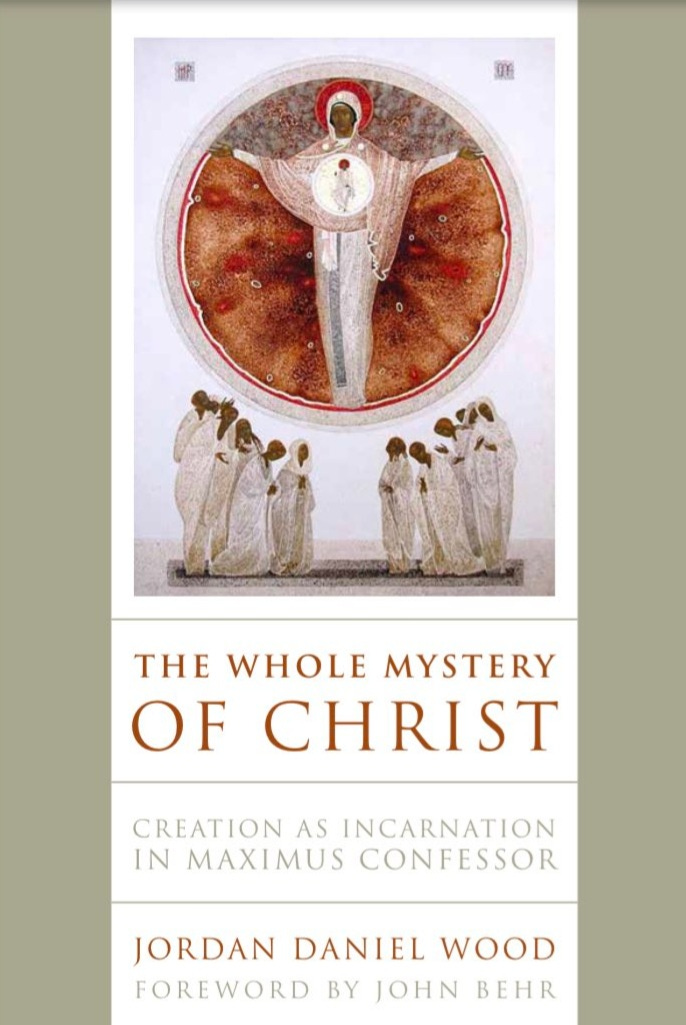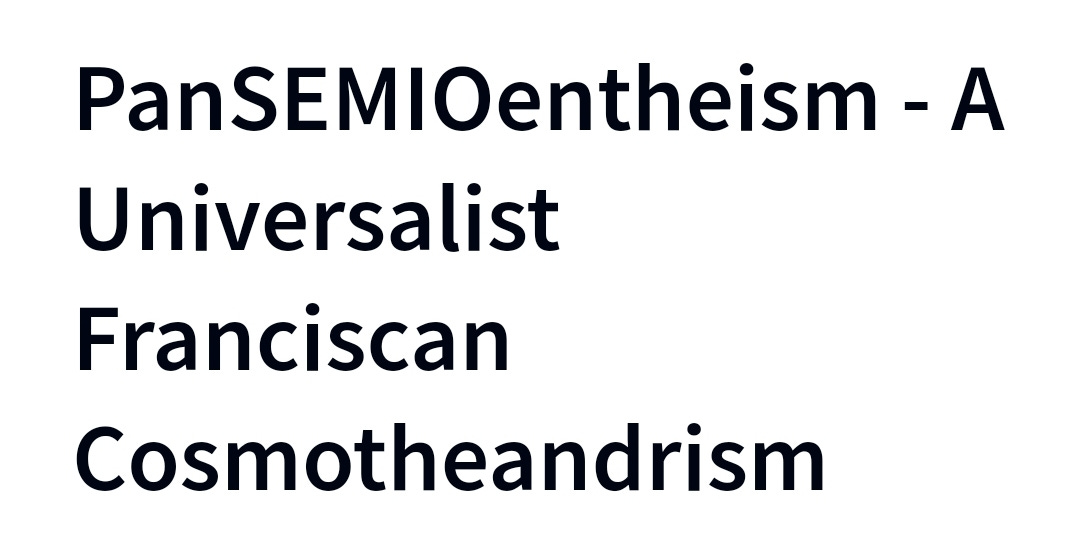Whose Christ? Which Monism?
Normatively, the metaphysical idiom that would most robustly cohere with and be most felicitously expressive of a proper Christological exegesis, then, would be a vague, exploratory heuristic that recognizes
because of revealed Christological kenosis, the paterological ur-kenosis
the primacy of Christ
hypostatic primacy
an authentic personalism
an analogy of being, naturally & participatorily, expressed via creative & imitative logoic dynamics
a univocity of howness, hypostatically & perichoretically, expressed via substrative & diffusive tropic dynamics
an hypostatic & perichoretic mereological panentheism
a relationality of hypostatic multiplicity
both theandric & cosmotheandric realities of an eternal creation
a radically, noncompetive volitional heuristic
a synergic mutual opposition, constitutively
a deeply communitarian ethos & profoundly unitive apokatastatic telos
How Do We Get There?
Any search for a metaphysical idiom that would most robustly cohere with and be most felicitously expressive of a proper Christological exegesis will boil down to a choice between - not pluralist, dualist or monist accounts, but - competing monisms.
While that search would ambition - not any comprehensive explanatory adequacy, but - only a robust exploratory heuristic, which would provision - not a precise definitive ontology, but - only a vague & descriptive phenomenology, it should be apparent at the outset that any analogia, alone, would still introduce unintelligible causal disjunctions, both epistemic & ontological.
I will assert but not explicate here what I believe to be a grasp of the obvious - that the monisms that compete are few: materialistic, pantheistic & panentheistic.
The next exploratory bifurcation will include, then, competing panentheisms, both mereological. Both mereological choices would refer - not naturally, as an analogia will still apply, but - hypostatically.
This final exploratory distillate will, therefore, ground our mereology in a heuristic that will be suggestive of a relationality of either hypostatic multiplicity or divisibility, put differently, between accounts that express any whole - part identity, constitutively, applying a radically noncompetive volitional heuristic.
Such a noncompetitive account would be modeled - not employing any synergistic | monergistic dichotomy (not in absolutistic terms, anyway), but - in constitutive terms of either a synergic mutual opposition or monergic divine fracture.
In some monergic accounts, while persons are undeniably dynamical, empirical & pragmatic selves, e.g. karmic bundles, they would otherwise remain indescribable due to an inescapable metaphysical ignosticism that's neither reductive nor eliminative.
In other monergic accounts, personhood might be described in terms that reduce to a merely unitary, rather than unitive, super-hypostatic entity, eschatologically. Here, one's realist stance regarding hypostases will have invoked hypostatic divisibility, only temporally.
Any essentially eliminativistic & nihilistic accounts were rejected at the outset of this decision tree - that being a materialist monism.
The above is my normative & abstract approach to choosing an appropriate heuristic. Concretely, it's neither a descriptive nor historical account of different pathways, although one should see some family resemblances.
The best shorthand for such an approach would be Neo-Chalcedonian Christology & Maximian Cosmology.
The best account of same will be published in 2022. Although my criteria above should not be taken as a wholly faithful interpretation thereof.
Another account that well coheres, an oldie but goodie:
Finally, my own semiotic account
re eternal creation, rather than controversially relating the transcendent & eternal w/the temporal via simultaneity, let me suggest, analogically, "presence."
What's eternally present to God re His freely & lovingly willed, gratuitous & contingent, creation would include - not undetermined, but - only wholly determined realities.
Concretely, the latter could refer to realities like logoi, teloi, necessary nomicities, apokatastasis; the former to our co-creative tropoi & self-determinations of our unique theotic trajectories & aesthetic scopes, as we enjoy our relative - not absolute - libertarian freedom.
This all entails that we choose - not whether, but - HOW we're saved as well as which beatitudes we'll pursue as we self-determine our temporal aesthetic scope.
I believe we'll similarly deliberate, still, in heaven, among its infinitely diverse & eternal well-being-nesses.
Finally, it doesn't follow, of necessity, that creation's eternality would make it a divine necessity vis a vis ad intra kenotic fullfilments?
Even taking creation as Incarnation and both as coeternal needn't obviate our distinctions between nature & will, naturale & intentionale, aesthetic intensity & scope, inviolable necessities & inevitable fittingnesses?
But I do think it will soften those overplayed dichotomies to view them more integrally.
Creation sans creation, for me, thus refers - not temporally or diachronically, but - to the sufficiency of ad intra Trinitological perichoresis & paterological ur-kenosis vis a vis the divine aesthetic intensity & intrinsic perfections.
I know this begs the question, for some, of whether we can be "really" related to God, whether immutability, impassibility & simplicity are threatened by the co-creative synergies of the above-listed undetermined realities.
And, resoundingly, I'd affirm that we CAN & DO change more than mere Divine Cambridge properties, that there's a thin passibility in play as God's aesthetic scope - not his intrinsic perfections - does change.
ETERNAL CONSTITUTIONAL DYNAMICS as distinct from TEMPORAL REVELATORY DYNAMICS
WHEN only applies to manifestations & not to the hypostatic - union, in & of itself
Terms like person, hypostasis, suppositum, subsistent, individual, enhypostatic, etc require a rigorous, fine - grained parsing.
B/c hypostasis refers to both idiomata & essential natures, & b/c tropoi are encoded in logoi, we'll still predicate some aspects of our hypostatic logic - not univocally, but - analogically, e.g. divine vs determinate primary natures, where univocity refers - not directly to things, but - other concepts. That's to say it refers semantically not ontologically, as a second intention.
While all hypostases, as thatnesses which exist for themselves, remain irreducible & indifferent to but inseparable from natures, still, they can otherwise be nondeterminate, self-determinate, in/determinate &, for tropoi, I like "relatively undetermined." All determinate particular hypostases will express the concrete Absolute neither exhausting nor being obliterated by it.
While all hypostases are enessenced & all essences are enhypostatic, the non/determinate (modal ontological) distinction matters when referring to the dynamics of exemplification vs instantiation, humanization vs divinization, en-essenc-ing via assumption vs synergic theosis, etc
Any phenomenology that addresses Christology will thus require a modal ontology, which, for determinate realities, will prescind from necessities to probabilities, and, for both divine & determinate realities, will employ - not a definitively robust metaphysic, but - a vaguely descriptive grammatical heuristic.
In some ways, it might appear that the non/determinate distinction introduces irreconcilable differences, then, between the infinite & finite, necessary & contingent, because the modal ontology of nondeterminate reality entails an extreme realism & immanent universals, while that of determinate reality entails a moderate realism & instantiated universals.
They can be reconciled conceptually, rather easily, though, because
1) those concepts are so vague,
2) many analogical, and
3) the univocal references apply to - not quiddity, but - only hypostatic hownesses.
Altogether, this makes our heuristics - not paraconsistent, but still - only weakly semi-formal. It’s a feature not a bug. We’re not trying to say more than we could possibly know or to effable about ineffable experiences.
The divine syllogistic refers moreso to modal identity dynamics, which are somewhat distinct from the determinate syllogistic of our modal ontology dynamics. In the former, identity reveals itself in any & all categories, i.e. essential, hypostatic & formal (think formatively about how secondary natures are variously assumed vs instantiated). In the latter, one's modal identity reveals itself only in the 3rd mode, i.e. formal identity. Because this mode includes both the telic-like dynamics of natural determinate becomings & contingent divine assumptions, it provisions a conceptual bridge between divine & determinate modal identities as revealed in various energeia (including the syn-ergic). The concrete Hypostatic Union provisions the actual, existential, personal, relation bridge.
This derivation of Aristotelian syllogistics from the modal identity heuristic employed for necessary realities is no ad hoc grammatical maneuver of a philosophical theology, because, metaphysically, it's how all heuristics distinguish between necessitarian axioms and contingent expressions, which is to say by leaving modal possibilities & actualities alone for both necessary & contingent realities, while otherwise prescinding from modal necessities to probabilities for contingent realities.
This is to say that I thus apply it whether parsing monistic, dualistic, pluralistic, materialistic, idealistic, pantheistic, theistic or panentheistic realities. To me, it's a vague phenomenology of emergentism sans supervenience is all.
More importantly, to me, this means that our derivation of determinate from divine syllogistics, via this semi-formal, semantical linkage of axiomatic & contingent realities, is not some ad hoc, mysterianistic evasion of intelligibility vis a vis our theology of nature.
No matter which metaphysic, these semantical strategies & speculative grammars remain exploratory heuristics and not explanatory ontologies. If there's not an inherent apophatic predication or mysterian appeal in a given heuristic, someone's proving too much & telling untellable stories.
One feature of such a modal ontology is that, while it can also bridge atemporal & temporal realities, apart from any temporal grammatical strategies to assign, for example, duration to eternalities, or simultaneity to temporalities (which is alright, I suppose, but, in some ways, not terribly intelligible), more importantly, it can bridge different types of PRESENCES, whose modal distinctions make very real phenomenological differences.
There can be a valid semantical univocity regarding the hownesses of different presences, which can be revealing of unique who-ness-es.
A practical upshot of the semi-formal syllogistics, above, is that our disjunctive transcendentals (like finite & infinite and contingent & necessary) suggest mutually constituted presences, whose very identities are grounded in their differences via oppositions that are mutual & integral.
So, as regarding stances that include such as creation as Incarnation & eternal creation, their intelligibility less so will derive from a/temporal predications and moreso from distinctions expressing the hownesses of the presences, who may be involved. Those distinctions suffice to reveal WHO is manifesting which energeia, opera & missions and HOW, even though we don't know the WHATness of their natures. What we do realize is that each person can synergically join those energeia, opera & missions to communally realize their teloi, while each person, thereby, also fullfills her unique tropic trajectory.
To the extent that our economic accounts are inherently Trinitarian, protologically with the Father, binatarian with the Incarnation, eternal creation can implicate an Incarnational manifestation of a coeternal pneumato-Christological presence in the coeternal creation, the Logos eternally containing (i.e. realizing hypostatic union) every un/created logoi (hence, also un/created teloi), then contingently expressing or manifesting a Christo-pneumatological presence, temporally.
The temporal WHEN dynamic refers moreso to the WHO & HOW of any given manifestation or revelation of a Divine Presence, less so having to do with a temporal account of the personal assumption of a secondary nature, constitutively. The temporal WHEN refers to a divine person's particular manifestation and not to any timing regarding the person's constitutive dynamics.
THAT there may be an eternal hypostatic union refers to a constitutive reality. WHEN refers to - not to constitutional, but - manifestational or revelatory dynamics.
Eternal Incarnation refers to the divine persons, constitutively, not to their temporal manifestations, revelatorily. Because human nature is microcosmic, as divinely assumed, we can refer to the eternal hypostatic union cosmotheandrically.
Temporal references apply - not to a divine person's constitutive dynamics, e.g. hypostatic union, but - to a person's revelatory dynamics, e.g. manifestations.






